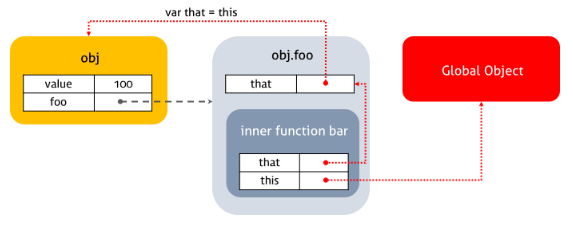this
자바스크립트의 함수는 호출될 때, 매개변수로 전달되는 인자값 이외에, arguments 객체와 this를 암묵적으로 받는다.
function square(number) {
console.log(arguments)
console.log(this)
return number * number
}
square(2)this를 이용하는 함수를 어떤 방식으로 실행하느냐에 따라서 this값이 결정된다. 즉, this에 바인딩할 객체가 동적으로 결정된다.
1. 일반 함수 실행 방식 (Regular Function Call)
전역객체(Global Object) : 모든 객체의 유일한 최상위 객체
-> 일반적으로 Browser-side에서는 widnow, Server-side(Node.js)에서는 global객체를 의미한다.
// in browser console
this === window // true
// in Terminal
node
this === global // truefunction foo() {
console.log(this)
}
foo() // window 객체let name = 'Shin'
function foo() {
console.log(this.name) // 'Shin'
}
foo()name변수는 전역 변수이기 때문에 전역 객체인 window에 속성으로 추가된다. 즉, let name = ‘Shin’; 이라는 코드를 쓰면 window 객체에 name이라는 key와 ‘Shin’이라는 value가 추가된다.
-> foo 함수를 일반 함수 실행 방식으로 실행하여기 떄문에, this는 window객체를 가리킨다.
-> console.log(this.name);은 console.log(window.name); 과 똑같아진다.
let age = 100
function foo() {
let age = 99
bar(age)
}
function bar() {
console.log(this.age)
}
foo()여기서도 마찬가지이다. foo함수 내부에서 bar함수가 일반 함수 실행 방식으로 실행된다. 일반 함수 실행 방식에서는 this가 window 객체를 가리키기 때문에, this.age는 window.age, 즉 99가 아닌 100이 출력된다.
let value = 1
let obj = {
value: 100,
foo: function () {
console.log("foo's this: ", this) // obj
console.log("foo's this.value: ", this.value) // 100
function bar() {
console.log("bar's this: ", this) // window
console.log("bar's this.value: ", this.value) // 1
}
bar()
},
}
obj.foo()메소드의 내부함수일 경우에도 위 코드처럼 this는 전역객체에 바인딩된다.
let value = 1
let obj = {
value: 100,
foo: function () {
setTimeout(function () {
console.log("callback's this: ", this) // window
console.log("callback's this.value: ", this.value) // 1
}, 100)
},
}
obj.foo()콜백함수의 경우에도 this는 전역객체에 바인딩된다.
내부 함수는 일반 함수, 메소드, 콜백함수 어디에 선언되었든 관계없이 this는 전역객체를 바인딩한다. 내부함수의 this가 전역객체를 참조하는 것을 회피하는 방법은 아래와 같다.
let value = 1
let obj = {
value: 100,
foo: function () {
let that = this // Workaround : this === obj
console.log("foo's this: ", this) // obj
console.log("foo's this.value: ", this.value) // 100
function bar() {
console.log("bar's this: ", this) // window
console.log("bar's this.value: ", this.value) // 1
console.log("bar's that: ", that) // obj
console.log("bar's that.value: ", that.value) // 100
}
bar()
},
}
obj.foo()* Strict mode에서의 일반 함수 실행 방식 (Regular Function Call in Strict Mode)
-
비엄격 모드(Sloppy mode)에서 자주 일어나느 다양한 실수들을 방지하여 각종 에러들을 감소시키기 위해 strict mode 사용함.
-
스크립트 코드 맨 상단에 ‘use strict’; 구문 추가
'use strict'
let name = 'Shin'
function foo() {
console.log(this.name) // error
}
foo()- strict mode에서 this는 무조건
undefined이다. - 보통 코드 작성할 때 this가 실수로 window객체로 인식되는 에러가 발생할 수 있는데, strict mode는 그러한 버그 발생을 애초에 방지해준다.
2. 도트 표기법 (Dot Notation)
우리가 Object를 만들고 그 Object의 key와 value를 부여한 후, 도트(.)로 값에 접근하는 방식
let age = 100
let ken = {
age: 35,
foo: function () {
console.log(this.age) //35
},
}
ken.foo()Dot Notation으로 함수가 실행되면, this는 그 도트 앞에 써있는 객체 자체를 가리킨다. 그러므로 this.age는 ken.age, 즉 35가 출력된다.
function foo() {
console.log(this.age)
}
let age = 100
let ken = {
age: 36,
foo: foo,
}
let wan = {
age: 32,
foo: foo,
}
ken.foo() // 36
wan.foo() // 32
let fn = ken.foo
fn() // 100ken.foo라는 값을 입력하고 fn(); 라고 실행하였다. 이는 함수를 Dot Notation이 아니고 일반 실행 함수 방식으로 실행한 것이다.
-> 그러므로 이 때의 this는 Global Object를 가리키고, 전역 변수 age의 값인 100이 출력된다.
function Person(name) {
this.name = name;
}
Person.prototype.getName = function() {
return this.name;
}
let me = new Person('Lee');
console.log(me.getName()); // 'Lee'
Person.prototype.name = 'Kim';
console.log(Person.prototype.getName()); / 'Kim'
프로토타입 객체도 메소드를 가질 수 있다. 프로토타입 객체 메소드 내부에서 사용된 this도 일반 메소드 방식과 마찬가지로 해당 메소드를 호출한 객체에 바인딩된다.
3. 명백한 바인딩 (Explicit Binding) / call, bind, apply
this의 역할을 우리가 직접 명확하게 지정해준다는 의미이다.
function.prototype.call, function.prototype.bind, function.prototype.apply와 같은 메소드를 사용하여 할 수 있다.
let age = 100
function foo() {
console.log(this.age)
}
let ken = {
age: 35,
log: foo,
}
foo.call(ken, 1, 2, 3)foo 함수의 인자로 각각 ken, 1, 2, 3을 주었다. 이 인자들 중에서 가장 첫 번째로 쓴 ken이 바로 this의 값으로 지정된다.
즉, this.age는 ken.age가 되어 35가 출력된다.
let age = 100
function foo() {
console.log(this.age)
}
let ken = {
age: 35,
log: foo,
}
foo.apply(ken, [1, 2, 3, 4, 5])apply또한 같은 역할을 수행한다. apply는 this의 값을 지정해주는 인자 외에도 배열을 인자로 넣을 수 있는데, 이 배열의 값이 순차적으로 foo함수의 인자가 된다.
let value = 1
let obj = {
value: 100,
foo: function () {
console.log("foo's this: ", this) // obj
console.log("foo's this.value: ", this.value) // 100
function bar(a, b) {
console.log("bar's this: ", this) // obj
console.log("bar's this.value: ", this.value) // 100
console.log("bar's arguments: ", arguments)
}
bar.apply(obj, [1, 2])
bar.call(obj, 1, 2)
bar.bind(obj)(1, 2)
},
}
obj.foo()위와 같이 bind도 사용할 수 있다.
4. new 키워드를 사용한 함수 실행
new 키워드를 사용하서 생성자 함수로 만들어 사용할 수도 있다. 이 경우에 this는 빈 객체가 된다.
function Person() {
console.log(this)
}
new Person()위 코드에서 this는 빈 객체를 가리키며 생성자 함수는 this라는 빈 객체를 return 한다.
-> return 문이 없어도 생성자 함수는 return해주는 특징을 지니고 있다.
function Foo() {
console.log(this.age) // undefined
this.age = 100 // 빈 객체에 속성 추가
console.log(this.age) // 100
}
new Foo()Foo 함수가 new 키워드와 함께 생성자 함수로 사용되는 즉시, 함수 내부의 this는 빈 객체가 된다.
-> this.age = 100;을 통해, 그 빈 객체에 age라는 속성이 추가되고 100이라는 값이 할당된다.
-> 그러므로, 두 번째 console.log(this.age) 는 100을 출력하고, Foo함수는 { age : 100 }이라는 객체를 return한다.
function Person() {
this.name = 'ken'
console.log(this)
}
// bad
let ken = Person()
console.log(you) // undefined
// good
let ken = new Person()
console.log(ken)- 만약 위 코드가 일반 함수 실행 방식으로 실행되었다면?
this는 window를 가리키게 될 것이고 window객체에 name이란 속성과 ‘ken’이라는 값이 추가되었을 것이다. 그리고 return문이 없기 때문에 어떠한 값도 리턴하지 않으므로 ken이라는 변수엔 어떤 것도 할당되지 않아 console 창에는undefined가 출력될 것이다. - new Person(); 처럼 생성자 함수 방식으로 실행되었다면?
this는 빈 객체를 생성하여 name이란 속성과 ‘ken’ 이라는 값을 할당할 것이고, return이 없음에도 불구하고 그 객체가 리턴된다. 그러므로 ken이라는 변수에는{ name : "ken" }이라는 객체가 할당되고 console.log에는 그 객체가 return된다.
function foo() {
this.age = 100
return 3
}
let a = new foo()
console.log(a)생성자 함수는 return문이 있음에도 불구하고 그 return문을 무시하고 this객체를 return하는 특징이 있다.
-> 즉, 위의 코드에서 3이 아닌 { age: 100 }이 return된다.
function foo() {
this.age = 100
return { haha: 200 }
}
let a = new foo()
console.log(a)그러나, 생성자 함수도 return되는 대상이 **객체**라면, this객체 대신 해당 객체가 return된다.
-> 즉, 위 코드에서는 a는 { age : 100 }이 아닌 { haha: 200 }`이 된다.
함정 문제
Q. ‘I can do my work! I am smart!’ alert가 출력이 될 것 인가?
function programmer() {
this.isSmart = false
this.upgrade = function (version) {
this.isSmart = !!version
work()
}
function work() {
if (this.isSmart) {
window.alert('I can do my work! I am smart!')
}
}
}
let programmer = new programmer()
programmer.upgrade(1.1)A. 출력하지 않는다
work() 함수가 일반 함수 실행 방식으로 실행되었으므로, work함수 안에서 this는 window 객체를 가리킨다. 전역 변수로 isSmart값을 지정하지 않았으므로 this.isSmart는 undefined이다.

